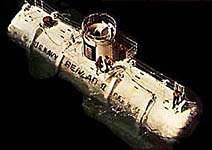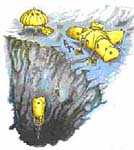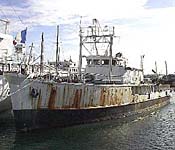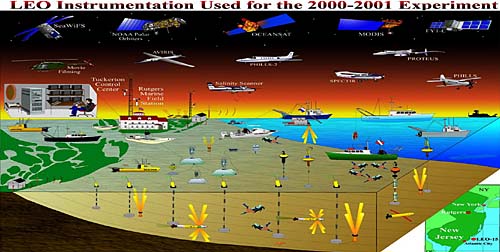From Sea to Shining Sea:
A Film Treatment by Paul Gasek and Gene Carl Feldman
Historical: subsequent Moon missions; Moon car speeding over lunar landscape.
Original: Interviews with Ballard, Earle, Carpenter, Piccard, about what happened after both missions and why manned missions were replaced by robotic ones. The value of manned exploration.
Within a few years after these two missions, American scientific institutions walk away from further manned exploration and development of the Moon and the oceans. The country is in a post-war recession, and manned missions are perceived as too expensive. The Apollo program has cost almost $14 billion, and the sticker shock ripples through the scientific community. Even though the Ben Franklin mission has cost less than $1 million, research budgets shrink and funding dries up. Some blame the cost/benefit analysis of manned exploration — robotic subs and spaceships do it cheaper, better, faster. Others credit a shift from general exploration to targeted research.
Whatever the reason, the effect on manned exploration of the oceans is profound. In the mid-60's, there are a dozen deep diving subs, and the oceans are heralded as the next frontier. In 1963, Jacques Cousteau declares, "...we believe sunken cantons and peopled reefs will become as commonplace on the Continental Shelf as oil drilling towers have in recent decades."

![]()

![]()

By the 90's, the national commitment to ocean exploration has retreated from those exciting days. The call to move into the oceans and use them to generate renewable energy, grow food for a hungry world, and mine minerals for industry has gone largely unheeded. Oceanography and marine research struggle for funding, and human explorers have been replaced in large part by unmanned data gatherers.
Animation: remote oceanic sensing system deployed worldwide.

The future of oceanic exploration maybe well lie in fleets of small, self-contained, robotic sensors, free-floating and roaming the oceans of the world, sending their data via satellite back to land-locked home offices for analysis. They’re less expensive to run and no human being has to take a risk to get the same information they provide. And it may well be that even more useful information can be gathered this way than from any manned mission to the oceans.
Students visiting Ben Franklin; interior scenes with students at controls
Interview: Sylvia Earle, Ben Franklin crew.
PREVIOUS PAGE | Page 20 | NEXT PAGE